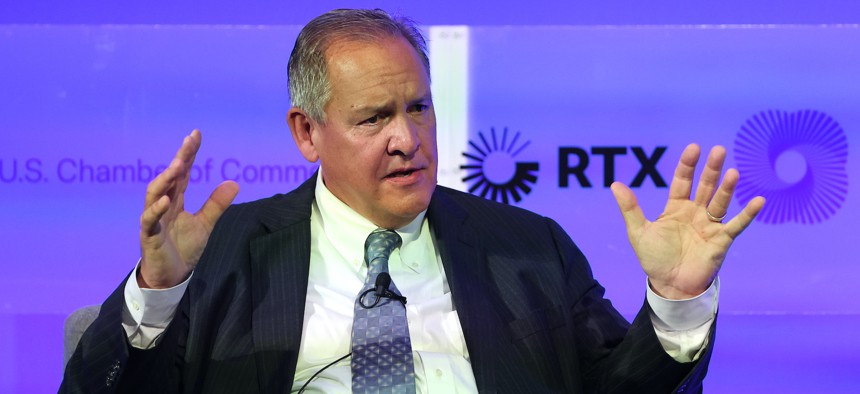
Gregory Hayes, Chairman and CEO of RTX, speaks at the U.S. Chamber of Commerce's Global Aerospace Summit on September 12, 2023 in Washington, DC. Getty Images / Kevin Dietsch
RTX CEO Greg Hayes to step down in May
President Chris Calio will take over as the company works to boost production of key weapons needed in Ukraine.
Christopher Calio will be the next CEO of RTX, replacing long-time leader Greg Hayes when he steps down in May in what the company called “a planned leadership transition.”
The move comes as the company works to increase production of key weapons given to the Ukrainian military and grapples with quality issues in its airliner engine manufacturing business.
"Today's announcement reflects the board's deliberate, disciplined succession planning process," Hayes said in a statement. "Chris has a deep understanding of the industry, our customers' needs, and our operations. I have every confidence in his ability to lead RTX and drive the company's long-term success."
The company said Hayes would continue to serve as executive chairman for an unspecified period after he steps down as CEO on May 2, a common practice during executive transitions.
Hayes has been an outspoken leader since his early days at the helm of the company formed by the April 2020 merger of United Technologies and Raytheon. Before becoming the RTX CEO, Hayes had been United Technologies’ chief executive since 2014.
In June 2020, he was among the defense CEOs to speak out against racism and discrimination after George Floyd, a Black man, was killed by white police officer. In 2022, Hayes moved the company’s corporate headquarters from Raytheon’s longtime home in Massachusetts to the Rosslyn neighborhood of Arlington, Virginia—not far from the Pentagon.
Hayes was critical of Lockheed Martin’s proposed acquisition of Aerojet Rocketdyne, a rocket engine supplier for RTX-made missiles. He also voiced concern about L3Harris Technologies’ bid to acquire Aerojet.
He pulled no punches in a December 2022 interview when he called Aerojet “the weak link” in the RTX supply chain, amid delayed rocket engine delivery and quality control problems.
More recently, he’s criticized the Pentagon’s slow pace in awarding replacement contracts for the thousands of weapons it’s given to Ukraine. The company has been a key supplier to the Ukrainian military, with its NASAMS, Patriot, Stinger missiles proving widely successful in shooting down Russian missiles and aircraft. The company’s Javelin, which it builds through a joint venture with Lockheed Martin, was credited with helping the Ukrainian military deter the Russian military’s attempt to capture Kyiv in the opening days of the conflict.
On the aerospace side of the house, a defect in Pratt & Whitney’s popular Geared Turbofan engine used on widely used Airbus A320neo aircraft prompted a $3 billion charge earlier this year. The manufacturing flaw ground hundreds of airliners through 2026 at a time of widespread increases in travel following the years of pandemic-driven declines.
Calio, who has been with Pratt & Whitney since 2005, was elevated to RTX’s chief operating officer in 2022. He became the company’s president in January and was put in charge of a reorganization that combined the company’s missiles and defense division and intelligence and space division into a single business unit.
On quarterly earnings calls, Calio has talked about the company’s supply chain issues. Earlier this month he filled in for Hayes at the Reagan National Defense Forum, a gathering of top defense officials and industry executives. During that discussion, he urged Congress to pass a $105 billion supplemental bill that would not only pay for weapons for Ukraine, but also make investments in defense manufacturing and the supply chain in the United States.
“If you're thinking about a healthy and resilient supply base ... you need a couple of basic things: You need a long-term demand signal and you need stable and secure funding,” Calio said. “You need that outward demand picture so that you can go make the investments you need, both in terms of capital, but in terms of people as well, to be able to meet the needs of our government and our allies.”
Previously called Raytheon Technologies, RTX, is America’s largest aerospace company and second largest defense company based on 2022 revenue.




